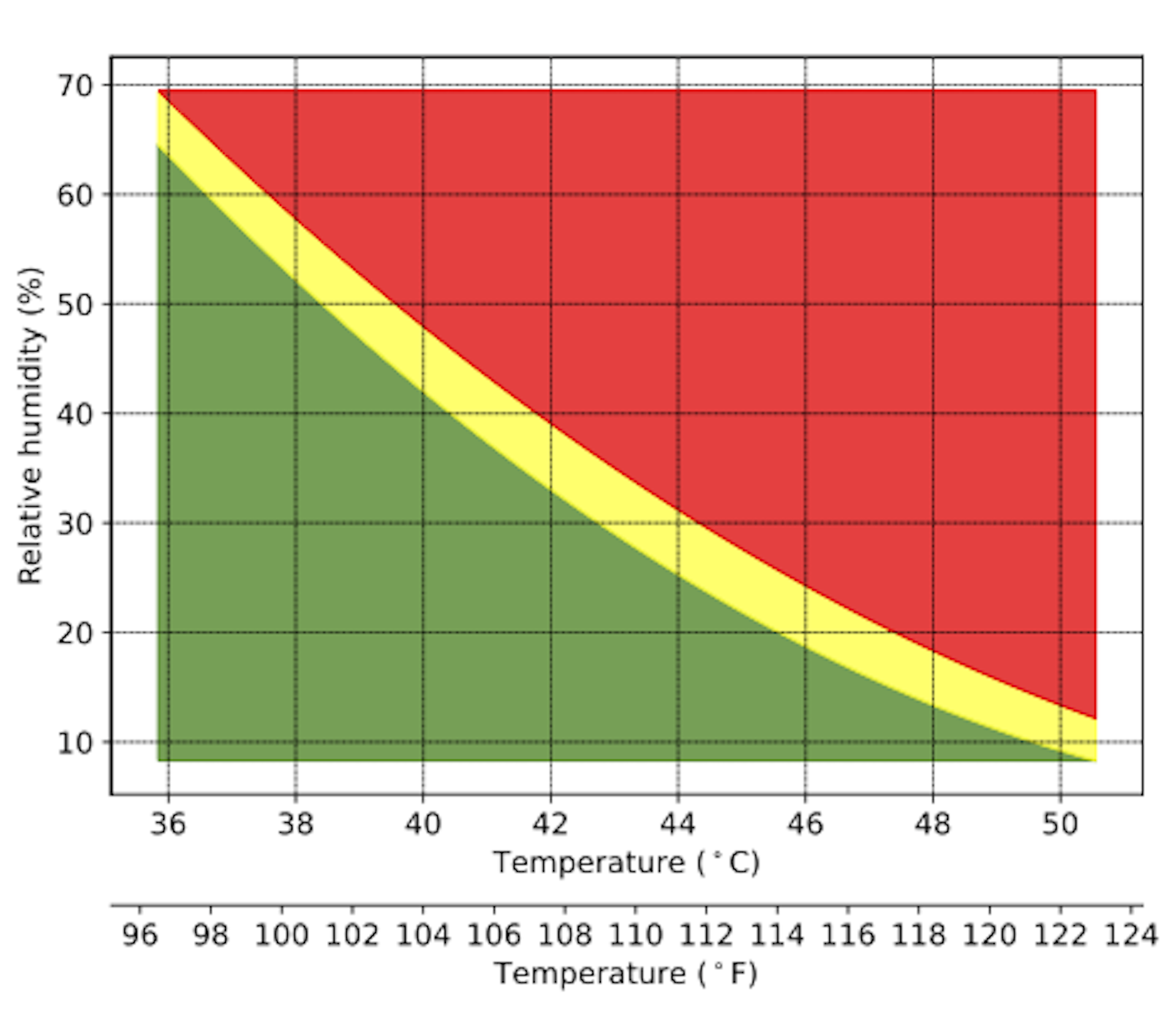Environment & Energy
Related: About this forumAs heat records fall, how hot is too hot for the human body?
Published: July 19, 2023 6.38pm CEST
W. Larry Kenney, Daniel Vecellio, Rachel Cottle, S. Tony Wolf, Penn State
Full article: https://theconversation.com/as-heat-records-fall-how-hot-is-too-hot-for-the-human-body-210088
Extreme heat has been breaking records across Europe, Asia and North America, with millions of people sweltering in heat and humidity well above “normal” for days on end.

Similar to the National Weather Service’s heat index chart, this chart translates combinations of air temperature and relative humidity into critical environmental limits, above which core body temperature rises. The border between the yellow and red areas represents the average critical environmental limit for young men and women at minimal activity. W. Larry Kenney, CC BY-ND
Heat waves are becoming supercharged as the climate changes – lasting longer, becoming more frequent and getting just plain hotter. One question a lot of people are asking is: “When will it get too hot for normal daily activity as we know it, even for young, healthy adults?”
-snip-
People often point to a study published in 2010 that theorized that a wet-bulb temperature of 95 F (35 C) – equal to a temperature of 95 F at 100% humidity, or 115 F at 50% humidity – would be the upper limit of safety, beyond which the human body can no longer cool itself by evaporating sweat from the surface of the body to maintain a stable body core temperature.
It was not until recently that this limit was tested on humans in laboratory settings. The results of these tests show an even greater cause for concern.
To answer the question of “how hot is too hot?” we brought young, healthy men and women into the Noll Laboratory at Penn State University to experience heat stress in a controlled environmental chamber. These experiments provide insight into which combinations of temperature and humidity begin to become harmful for even the healthiest humans.
-snip-
Our studies on young healthy men and women show that this upper environmental limit is even lower than the theorized 35 C. It occurs at a wet-bulb temperature of about 87 F (31 C) across a range of environments above 50% relative humidity. That would equal 87 F at 100% humidity or 100 F (38 C) at 60% humidity.
-snip-
Full article: https://theconversation.com/as-heat-records-fall-how-hot-is-too-hot-for-the-human-body-210088
orthoclad
(2,910 posts)A key factor in the study: "young and healthy". They were going for defining conditions where it would be impossible to maintain life. But as we saw in the heat wave in Italy, people with heart conditions were dying at much less extreme temperature and humidity conditions.
And even for the young and healthy, the limit is far below the 95F wet bulb threshold; the study cites a wet bulb temp of 87F. From the article:
Each participant swallowed a small telemetry pill that continuously monitored their deep body or core temperature. They then sat in an environmental chamber, moving just enough to simulate the minimal activities of daily living, such as showering, cooking and eating. Researchers slowly increased either the temperature in the chamber or the humidity in hundreds of separate experiments and monitored when the subject’s core temperature started to rise.
That combination of temperature and humidity at which the person’s core temperature starts to continuously rise is called the “critical environmental limit.”
...
Current heat waves around the globe are exceeding those critical environmental limits, and approaching, if not exceeding, even the theorized 95 F (35 C) wet-bulb limits.
In the Middle East, Asaluyeh, Iran, recorded an extremely dangerous maximum wet-bulb temperature of 92.7 F (33.7 C) on July 16, 2023. India and Pakistan have both reached hazardous levels in recent years, as well.
Experimental subjects were young, healthy, and doing mild activity. Unlike the young, healthy cable worker in Texas who died of heat stroke while his boss accused him of being on drugs.
It's happening, people. We are driving the environment into unsurvivable conditions. Mostly in Global South countries, who contribute realtively little per-capita greenhouse gas. Pakistan asked for compensation after half the country flooded; climate reparations are entering the conversation.
Some of these countries have nukes.